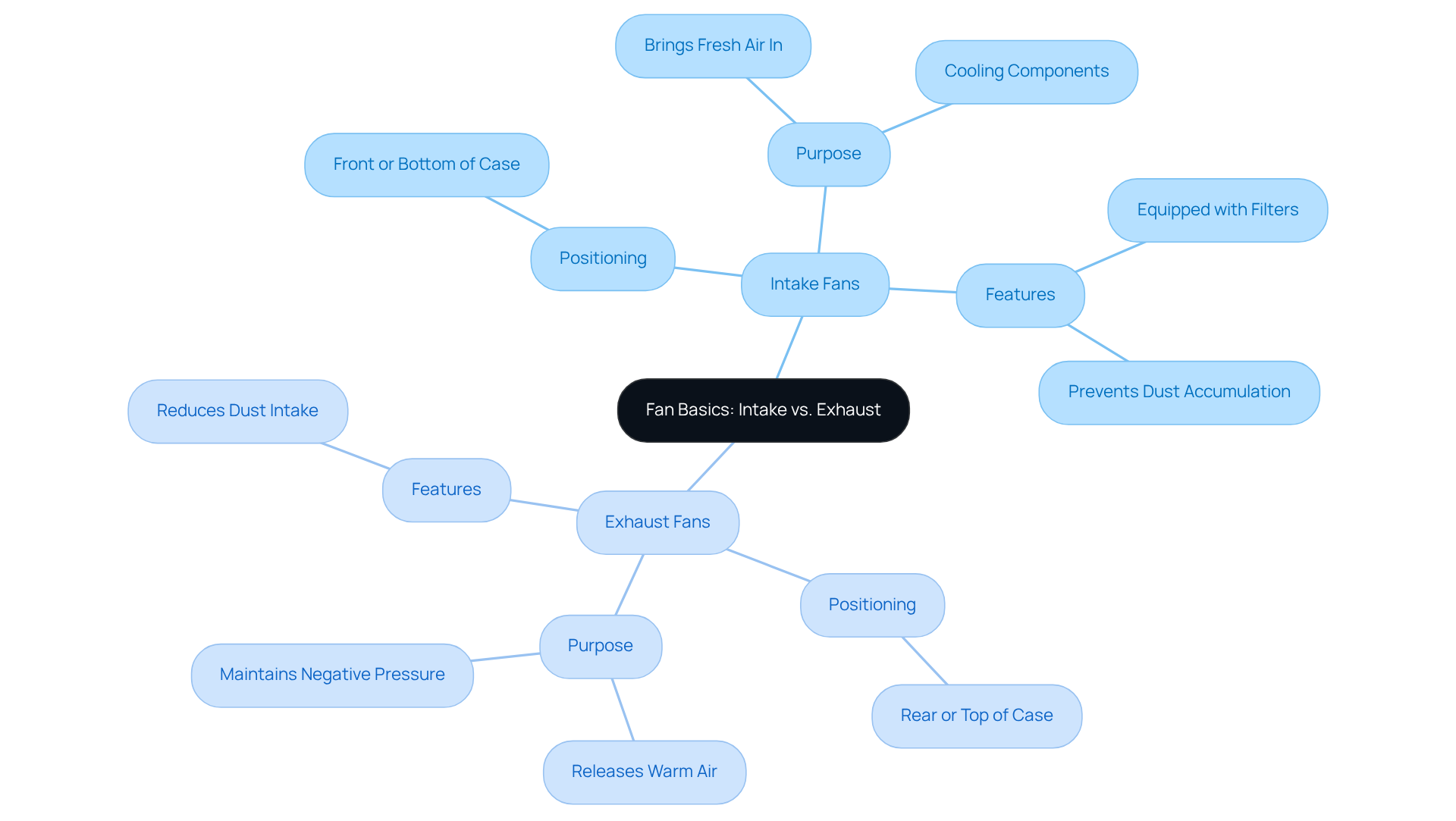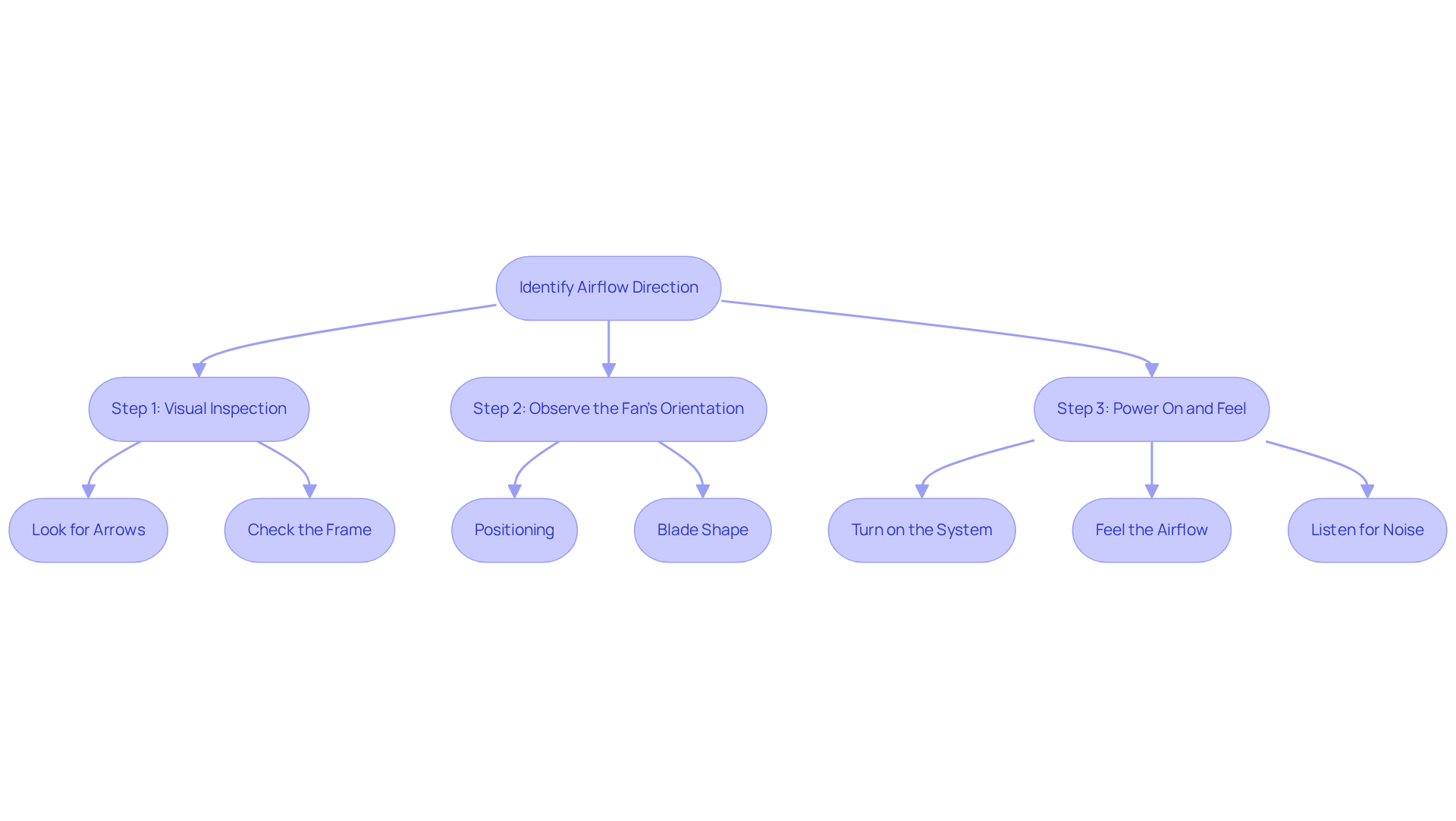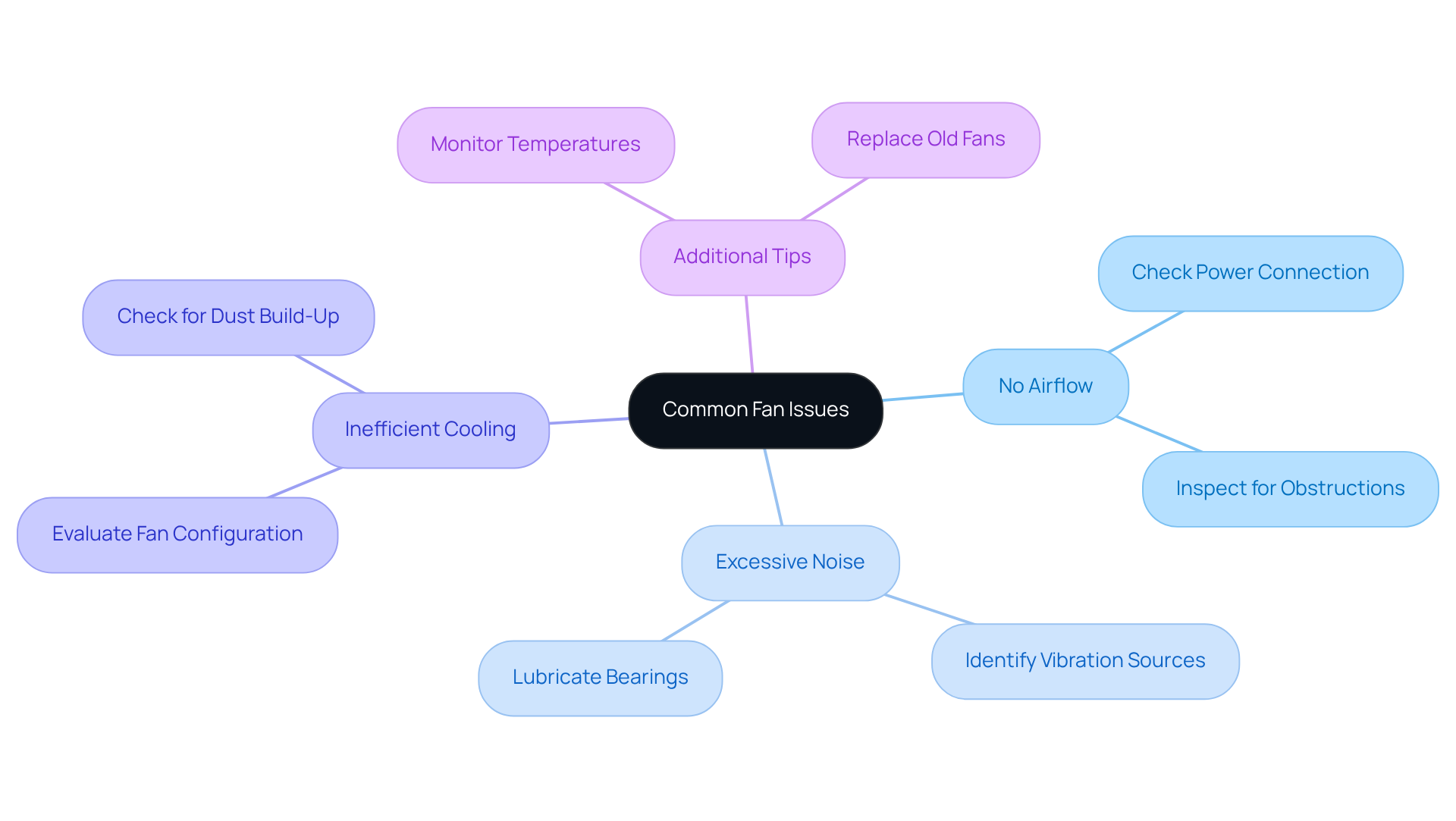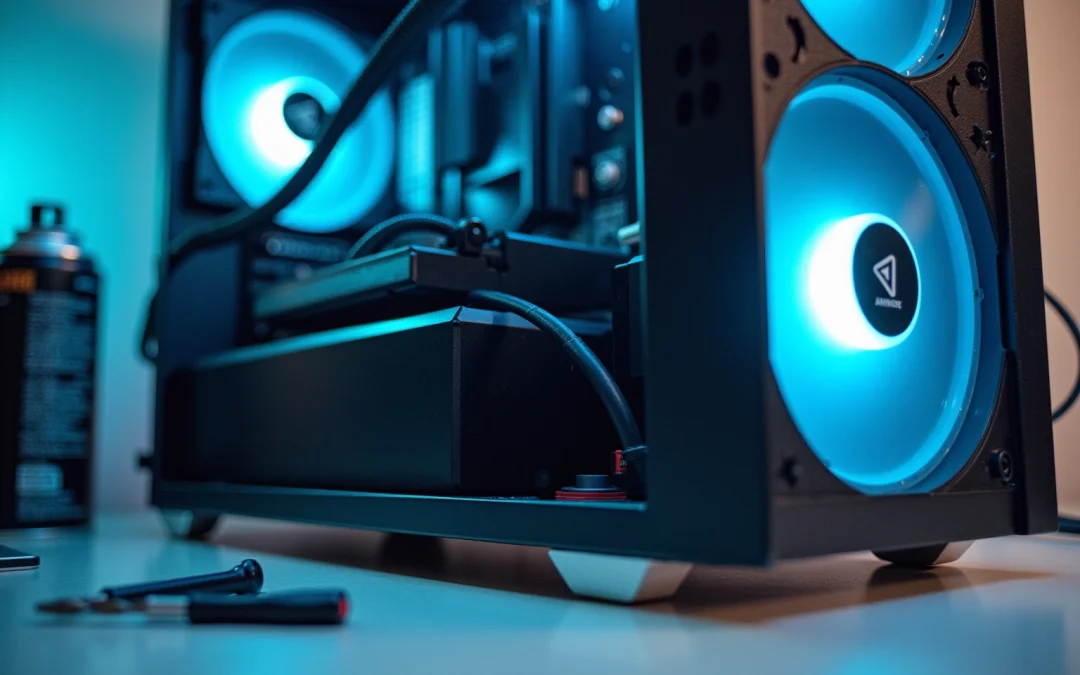Overview
To determine whether a fan functions as an intake or exhaust type, one must carefully inspect visual indicators, including airflow direction arrows, fan orientation, and the airflow experienced when the fan is powered on. This article elucidates the key characteristics and positioning of intake and exhaust fans, providing a systematic guide for identifying their functions through physical inspection and an understanding of airflow dynamics. By following these guidelines, readers can confidently ascertain the role of their fans and optimize their systems accordingly.
Introduction
Understanding the distinction between intake and exhaust fans is essential for anyone aiming to optimize the cooling systems of their electronic devices. These two types of fans play pivotal roles in maintaining thermal efficiency; however, identifying each one can often present a challenge.
What methods can be employed to accurately determine a fan’s airflow direction, and why does this knowledge matter for performance and longevity? This guide delves into the nuances of fan identification, offering step-by-step techniques that ensure setups remain cool and efficient.
Understand Fan Basics: Intake vs. Exhaust
Fans are classified into two primary types based on their airflow direction, which is how to tell if a fan is intake or exhaust. Intake blowers are designed to bring fresh air into a setup, typically positioned at the front or bottom of a case, while ventilation units are responsible for releasing warm air outside, usually located at the rear or top. Recognizing how to tell if a fan is intake or exhaust is crucial for maintaining optimal thermal conditions in electronic devices. Intake units play a vital role in cooling components by introducing cooler air, whereas exhaust units effectively eliminate hot air, thereby preventing overheating. A thorough understanding of how to tell if a fan is intake or exhaust will facilitate the establishment of a setup that maximizes efficiency.
Gagner-Toomey Associates, the world’s largest manufacturer of standard and custom air-movers for cooling, provides an extensive product line of DC input tube axial fans and centrifugal blowers, optimized for performance, efficiency, and low noise. Their innovative cooling solutions are indispensable for electronics, automotive, telecom, and industrial applications, with sizes ranging from 15mm to 910mm and IP protection available upon request.
Key Characteristics:
-
Intake Fans:
- Positioned to pull air into the system.
- Often equipped with filters to prevent dust accumulation.
- Typically located at the front or bottom of the case.
-
- Positioned to push air out of the system.
- Help maintain negative pressure, which can reduce dust intake.
- Usually found at the rear or top of the case.
Visual Indicators:
- Look for arrows on the fan casing indicating airflow direction.
- The side with the motor and label is generally the discharge side, while the opposite side serves as the intake side.
Recent advancements in fan technology have underscored the importance of airflow direction in electronic cooling mechanisms. A significant proportion of contemporary electronic setups utilize both intake and discharge blowers to achieve optimal thermal regulation. Case studies have illustrated that appropriate fan placement and airflow direction can enhance cooling performance and system reliability. Engineers assert that understanding these distinctions is essential for effective thermal management, ultimately improving device performance and longevity.

Identify Airflow Direction: Step-by-Step Methods
To determine whether a fan serves as an intake or exhaust, follow these essential steps:
Step 1: Visual Inspection
- Look for Arrows: Most fans feature arrows on their casing that indicate the airflow direction. An arrow pointing toward the fan helps explain how to tell if a fan is intake or exhaust, while one directing away indicates the opposite.
- Check the Frame: If the fan has a visible frame, the section with the frame typically represents the intake area. Conversely, the portion lacking a frame usually denotes the discharge area.
Step 2: Observe the Fan’s Orientation
- Positioning: When mounted in a case, observe the fan’s orientation. In learning how to tell if a fan is intake or exhaust, you can observe that fans with the motor facing inward are likely intake fans, while those with the motor facing outward are discharge fans.
- Blade Shape: The curvature of the blades also provides insights. Blades curving toward the intake side are designed to pull air in, while those curving toward the discharge side are intended to push air out.
Step 3: Power On and Feel
- Turn on the System: If it is safe to do so, power on the system and feel the airflow. Stand in front of the fan; if you feel air being drawn towards you, it is an intake fan. If air is being expelled away, it is an example of how to tell if a fan is intake or exhaust.
- Listen for Noise: Intake blowers may produce distinct sounds compared to exhaust units due to differing airflow dynamics. Pay close attention to the noise level and quality as an additional indicator.

Troubleshoot Common Fan Issues: Ensuring Optimal Performance
To maintain optimal fan performance, troubleshooting common issues is essential:
Issue 1: No Airflow
- Check Power Connection: Ensure the fan is properly connected to the power source. A loose or faulty connection may prevent it from spinning.
- Inspect for Obstructions: Look for debris or dust blocking the fan blades. Regular cleaning of the fan and surrounding area is crucial for unobstructed airflow.
Issue 2: Excessive Noise
- Identify Vibration Sources: Noisy fans often result from vibrations. Ensure the fan is securely mounted and check for loose screws or brackets that may contribute to noise.
- Lubricate Bearings: Older units may require lubrication of the bearings. Applying a small amount of appropriate lubricant can significantly reduce noise levels. Poor lubrication in the bearing system can lead to metal-to-metal contact and increased heat generation.
Issue 3: Inefficient Cooling
- Evaluate Fan Configuration: A balanced setup between intake and exhaust fans is vital for effective cooling. Ideally, understanding how to tell if a fan is intake or exhaust can help ensure that there are more intake vents than exhaust, which assists in maintaining positive pressure and improving airflow.
- Check for Dust Build-Up: Dust accumulation can severely hinder airflow. Regular cleaning of fans and filters is necessary to sustain efficiency.
Additional Tips:
- Monitor Temperatures: Utilize software tools to keep track of system temperatures. Consistently high temperatures may indicate the need to adjust fan speeds or configurations. Improving ventilation systems can lead to energy savings of up to 40% in commercial buildings.
- Replace Old Fans: If a fan consistently underperforms despite troubleshooting efforts, consider replacing it with a new, more efficient model. Regular maintenance and timely replacements can extend the lifespan of HVAC equipment by up to 50%, as noted by ASHRAE (2018).
- Quote from Industry Professional: “Be on the lookout for any strange noises that indicate a problem with the motor.” – Pete Meier, Creative Director, Technical.

Conclusion
Understanding the distinctions between intake and exhaust fans is crucial for achieving efficient cooling in electronic systems. By clearly recognizing the functions of each type of fan and their specific placements within a setup, optimal thermal conditions can be established, thereby enhancing overall device performance and longevity.
Key points include:
- Visual indicators for identifying fan types, such as airflow arrows and blade orientation
- Practical steps for determining airflow direction
- Addressing common fan issues—like airflow problems, excessive noise, and inefficient cooling—can significantly enhance fan performance
- Regular maintenance and proper configuration of intake and exhaust fans are essential for sustaining balanced airflow, ultimately leading to improved thermal management
In conclusion, mastering the identification of intake versus exhaust fans not only contributes to effective cooling solutions but also underscores the significance of airflow in electronic systems. With this knowledge, individuals can take proactive measures to optimize their setups, ensuring devices operate efficiently and remain safeguarded against overheating. Embracing these practices can result in enhanced performance and extended lifespans for electronic equipment, representing a valuable investment for anyone seeking to refine their cooling strategies.
Frequently Asked Questions
What are the two primary types of fans based on airflow direction?
The two primary types of fans are intake fans, which bring fresh air into a setup, and exhaust fans, which release warm air outside.
Where are intake fans typically located?
Intake fans are usually positioned at the front or bottom of a case.
What is the role of intake fans in electronic devices?
Intake fans introduce cooler air to help cool components, preventing overheating.
Where are exhaust fans commonly found?
Exhaust fans are typically located at the rear or top of a case.
How do exhaust fans contribute to thermal management?
Exhaust fans push hot air out of the system and help maintain negative pressure, which can reduce dust intake.
What visual indicators can help identify the airflow direction of a fan?
Look for arrows on the fan casing that indicate airflow direction; the side with the motor and label is generally the discharge side, while the opposite side serves as the intake side.
Why is it important to understand the difference between intake and exhaust fans?
Understanding the distinction is crucial for maintaining optimal thermal conditions, enhancing cooling performance, and improving system reliability.
What advancements have been made in fan technology regarding airflow direction?
Recent advancements emphasize the importance of airflow direction in electronic cooling mechanisms, with many contemporary setups utilizing both intake and exhaust fans for optimal thermal regulation.

